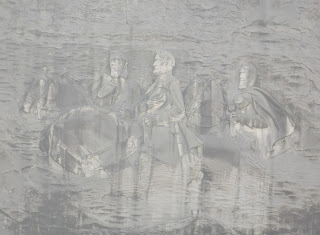Not a good picture, seems the figures have faded on the rock surface since I last had viewed them. First man is Jefferson Davis, the second is Robert E. Lee and the last is of Stonewall Jackson. Gutzon Borglum was commissioned to do the carving but abandoned the project in 1925 (and later went on to do Mount Rushmore). Carving on Stone Mountain was completed by Roy Faulkner in 1975. After viewing the carving we drove over to the other side of the mountain to hike the Walk Up Trail. The path is 1.3 miles, ascending 78 feet in elevation to a height of 1,686 feet. It was an unusually warm day for Atlanta in December, but the lower slopes of the mountain are forested and shady. The top of the mountain is a landscape of bare rock, and at that height the atmosphere was a bit cool. We made it to the top!
From this height we could see downtown Atlanta, as well as the park spread out below us. In the background is Stone Mountain Lake.
Three days later we arrived in Carbondale to assist our daughter and her husband pack for their move to Florida. And on December 19th our son-in-law Spencer graduated from law school. The past three years has not been easy for him and Melissa, but those years did bring the joy of the birth of their son Nathan. I must say that graduation day was a very happy one for all of us!
We are now back at our home in St.Petersburg. We made it home in time for the arrival of our son Dan and wife Amanda from D.C., who spent Christmas with us. And we now have another cat residing with us, Zelda. She belongs to Spencer and Melissa who at present cannot have her with them. When things settle down there will probably be more postings, as we have a lot to see and do in the Tampa-St.Petersburg area.





















































